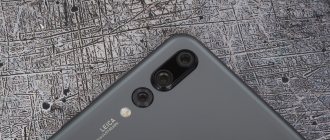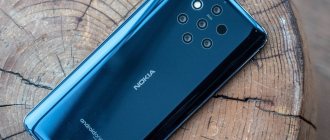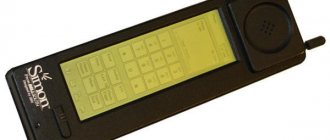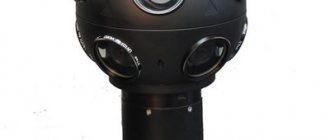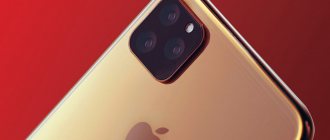Huawei Mate 30 Pro (121)
This is not the first time that Huawei smartphones top the DXOMARK rating. So Huawei Mate 30 Pro took the honorable first place.
The main feature of the smartphone camera is the presence of a separate 40-megapixel module for video recording (wide-angle). The resolution of the main module for photography is also 40 MP. There is also a lens for 3X zoom with optical stabilization and an additional one for background blur.
Experts say that the Mate 30 Pro takes better pictures than the P30 Pro: during the day there is more detail in the corners, at night there is less noise and more high-detail images in general. And the P30 Pro, as we know, was previously one of the best camera phones on the planet.
Let's note the various filters, night and portrait modes.
- Screen diagonal: 6.53 inches
- Screen resolution: 2400×1176
- Weight: 298 g
- Number of SIM cards: 2
- Processor: HiSilicon Kirin 990
- Memory capacity: 256 GB
- RAM capacity: 8 GB
- Battery capacity: 4500 mAh
- Rear camera: 4 modules
- Front camera: 32 MP
- Memory card support: yes
Xiaomi Mi CC9 Pro Premium Edition (121)
The appearance of Xiaomi Mi CC9 Pro Premium Edition in the top was extremely unexpected - the smartphone immediately earned 121 points!
It is noted that this is the first serial smartphone with a module that has a huge resolution of 108 MP (optical stabilization is supported). Of course, by default it shoots in a much lower resolution (108 MP must be forced - this is normal, almost all companies do this).
In addition to the main sensor, it received four more: for macro photography, telephoto for portrait photography, telephoto with optical zoom and stabilizer, and wide-angle with a viewing angle of 117 degrees.
Excellent shooting is noted both with a sufficient amount of light and at dusk or at night.
- Screen diagonal: 6.47 inches
- Screen resolution: 1080×2340
- Weight: 208 g
- Number of SIM cards: 2
- Processor: Qualcomm Snapdragon 730G
- Memory capacity: 128 GB
- RAM capacity: 6 GB
- Battery capacity: 5260 mAh
- Rear camera: 5 modules 108/8/20/12/2 MP
- Front camera: 32 MP
- Memory card support: no
Google Pixel 2
Can be purchased for 45,380 rubles.
DxOMark rating - 98
Google Pixel 2 is a clear example that two rear cameras are not always better than one. This small 5-inch phone also features an extremely convenient way to call Google Assistant. Just squeeze the sides of the phone. It's much easier than accidentally pressing another button (Bixby) on the Samsung Galaxy S9 Plus.
The latest games will run smoothly on the Pixel 2 thanks to the Qualcomm Snapdragon 835 processor, 4 GB of RAM and 64 to 128 GB of storage for user data.
The 12.2 MP rear camera with F/1.8 aperture is the best part of the Pixel 2. The color reproduction is true to life and the photos look vibrant. Even photos taken in low light using the Pixel 2 look like we turned on the lights.
Both the 8MP front and rear cameras have a background portrait blur mode. This phone also has optical image stabilization and very fast laser autofocus.
Pros:
- Fits comfortably in the palm of your hand.
- Has an NFC chip.
- Has moisture protection class IP67.
- It holds a charge for a long time, despite the seemingly modest battery capacity of 2700 mAh.
- Excellent stereo speakers.
Minuses:
- A memory card cannot be inserted.
iPhone 11 Pro Max 256GB (117)
Apple smartphones are traditionally good at photography, as evidenced by the 117 DXOMARK rating points - we're talking about the iPhone 11 Pro Max model. True, all this also applies to another smartphone - the iPhone 11 Pro, since the cameras in these devices are identical.
The main noticeable difference from its predecessor is the new triple camera module, which consists of three sensors: telephoto module, wide-angle and ultra-wide-angle (f/1.8 + f/2.0 + f/2.4). Optical stabilization is present in two sensors - wide-angle and telephoto.
A new feature is the night mode, in which the camera takes several pictures at the same time, and then stitches them together, producing the highest quality result. And it works.
We note phase autofocus and 4K 60 fps shooting.
- Screen diagonal: 6.5 inches
- Screen resolution: 2688×1242
- Weight: 226 g
- Number of SIM cards: 2 (nano SIM + eSIM)
- Processor: Apple A13 Bionic
- Memory capacity: 256 GB
- RAM capacity: 4 GB
- Battery capacity: 3500 mAh
- Rear camera: triple 12/12/12 MP
- Front camera: 12 MP
- Memory card support: no
Samsung Galaxy Note 10+ 12/256GB (117)
It would be strange if a smartphone from Samsung, one of the leaders in terms of cameras, did not make it into the top. The Galaxy Note 10+ received a whopping 117 points. As before, the Galaxy Note line boasts a stylus that is hidden inside the case.
This version has four main camera modules: wide-angle (f/1.5-f/2.4), ultra-wide-angle (f/2.2), telephoto lens (f/2.1), 3D depth camera. As you can replace, the aperture ratio for the main module is variable - this feature was also used on some of the company’s previous flagships (improves the quality of photography either during the day or at night). Also, optical stabilization is announced for the main (wide-angle) module.
Although the front camera is single, some experts call it perhaps the best on the market.
Opacity of ratings
Each assessment consists of a large number of items. But there is one “but”, with a score of 118 points, the current leader of the rating, Samsung Galaxy Note 10+ 5G, does not have a score above 100 for photos in any of the points.
It is not clear how the score is formed and how it goes beyond 100 points (if each individual sub-item of the test is below 100 points). Most likely there are some coefficients and so on, but it’s impossible to figure it out!
At the HONOR 20 presentation, we asked DxOmark specialists about the methodology and rating. And we heard the answer that the testing methodology is not a secret, it can be found on the website! But how the assessment is formed and BY WHAT FORMULA is a secret!
Huawei P30 Pro (116)
Not so long ago, this smartphone was the leader of the rating. Actually, this is still one of the best camera phones today, and at a fairly reasonable price.
The rear camera is represented by 4 modules: the main one with optical stabilization (40 MP, f/1.6), wide-angle (20 MP, f/2.2), telephoto lens with 5x optical and 10x hybrid zoom (f/3.4), ToF camera. As in other smartphones, by default the main module shoots in a much lower resolution - 10 MP, and 40 MP is forced.
Phase and contrast autofocus, laser autofocus are announced.
- Screen diagonal: 6.47 inches
- Screen resolution: 2340×1080
- Weight: 192 g
- Number of SIM cards: 2
- Processor: HiSilicon Kirin 980
- Memory capacity: 256 GB
- RAM capacity: 8 GB
- Battery capacity: 4200 mAh
- Rear camera: triple 40/20/8 MP
- Front camera: 32 MP
- Memory card support: yes
Huawei P40 Pro – 128 points
Like many other smartphones, the P40 Pro has technology to improve dynamic range and evening shooting capabilities by combining pixels. In reality, this has a positive effect on shooting in any conditions. There is good optical stabilization on board, and thanks to it, a telephoto lens with 5x zoom can surprise even an experienced photographer. The level of detail is impressive, the noise level is extremely low even taking into account all the magnification factors.
Experts note that the ultra-wide-angle lens offers better picture quality compared to any other mobile camera. The main thing is that the dynamic range is wide and the detail is excellent. The bokeh mode also produces high-quality images, clearly distinguishing the subject from the background.
Full description of Huawei P40 Pro on DxOMark
Samsung Galaxy S10 5G (116)
Let’s say right away that this smartphone, which supports 5G networks, is not officially sold here. It's a shame because it differs significantly from the regular S10: a ToF sensor (depth of field sensor) has been added to the main module. Also, apparently, the software has changed significantly, since the camera itself shoots much better than the Galaxy S10/S10+: more accurate white balance, much better blur effect, even more accurate autofocus, etc.
But the modules themselves remained unchanged: the main wide-angle with variable aperture f/1.5-f/2.4, ultra-wide-angle with f/2.2 aperture, telephoto with f/2.2 aperture.
- Screen diagonal: 6.1 inches
- Screen resolution: 3040×1440
- Weight: 157 g
- Number of SIM cards: 2
- Processor: Exynos 9820
- Memory capacity: 128 GB
- RAM capacity: 8 GB
- Battery capacity: 3400 mAh
- Rear camera: triple 16/12/12 MP + ToF
- Front camera: 10 MP
- Memory card support: yes
OnePlus 7 Pro (114)
The OnePlus 7 Pro also earned a fairly large number of points, although OnePlus smartphones usually do not reach the top level.
Why did OnePlus 7 Pro manage to score as much as 114 points? Thanks to the main camera, which received three modules: main (48 MP, f/1.6), wide-angle (16 MP, f/2.2), telephoto lens (8 MP, f/2.4). Optical stabilization is announced for two sensors: the main and telephoto module.
It is noted that OnePlus 7 Pro now takes great pictures not only during the day, but also at night. It is quite possible that the issue is the night mode, which is supported by these smartphones.
- Screen diagonal: 6.67 inches
- Screen resolution: 3120×1440
- Weight: 206 g
- Number of SIM cards: 2
- Processor: Qualcomm Snapdragon 855
- Memory capacity: 256 GB
- RAM capacity: 8 GB
- Battery capacity: 4000 mAh
- Rear camera: triple 48/8/16 MP
- Front camera: 16 MP
- Memory card support: no
OnePlus 6 8/128GB
96 points.
The main module of the rear camera Sony IMX519 has a resolution of 16 MP (f/1.7) with optical image stabilization and 4K video recording. The second Sony IMX 376K module has a resolution of 20 MP (f/1.7) with zoom and the ability to blur the image.
The front camera is single, its resolution is 16 MP (f/2.0).
- Screen diagonal / resolution: 6.28 inches / 2280×1080
- Device weight: 177 g
- Processor: Qualcomm Snapdragon 845
- RAM / internal memory: 8 GB / 128 GB
- Battery capacity: 3300 mAh
- Memory card slot: no
Honor 20 Pro (113)
The 20 Pro is Honor's flagship smartphone, but when it comes to its price, it's more of a mid-range model. Nevertheless, it received a really decent camera, and the DXOMARK expert rating rated it 113 points.
How did you manage to win such a large number of points? The main camera has four sensors: the main one with optical and electronic stabilization and laser focusing (48 MP), wide-angle (16 MP), telephoto sensor with 3x optical zoom. The last module is for macro photography, its resolution is small - only 2 MP. It is believed that the last module is nothing more than a tribute to marketers, but even if so, the camera takes excellent pictures in any case, and even more so considering the cost of the smartphone.
- Screen diagonal: 6.26 inches
- Screen resolution: 2340×1080
- Weight: 182 g
- Number of SIM cards: 2
- Processor: HiSilicon Kirin 980
- Memory capacity: 256 GB
- RAM capacity: 8 GB
- Battery capacity: 4000 mAh
- Rear camera: four modules 48/16/8/2 MP
- Front camera: 32 MP
- Memory card support: no
Samsung Galaxy S10+ (113)
The Galaxy S10+ scored an impressive 113 points. This also includes the Galaxy S10, since their cameras are completely identical. True, in some reviews, experts sometimes notice a slight difference between the same cameras of different smartphone models (this does not apply specifically to Samsung, but to other manufacturers as well), but this, I think, can be attributed to an error.
It uses a triple module: a wide-angle sensor with a variable aperture f/1.5-f/2.4 (12 MP), an ultra-wide-angle sensor with an aperture f/2.2 (16 MP), a telephoto lens with an aperture f/2.2 (12 MP).
The camera takes excellent pictures, not only during the day, but also at dusk or at night.
- Screen diagonal: 6.4 inches
- Screen resolution: 3040×1440
- Weight: 175 g
- Number of SIM cards: 2
- Processor: Exynos 9820
- Memory capacity: 128 GB
- RAM capacity: 8 GB
- Battery capacity: 4100 mAh
- Rear camera: triple 16/12/12 MP
- Front camera: 10 MP
- Memory card support: yes
Google Pixel 4 (112)
According to experts, the Google Pixel 4 is still a great camera phone, but it still falls a little short - the photos do not reach the tops like the Huawei Mate 30 Pro or iPhone 11 Pro. But before, “pixels” were considered top-end camera phones. However, as they say, it’s not over yet - it’s quite possible that the camera will be “updated” programmatically with the help of firmware updates and then it will give the leaders of the rating a hard time.
Interestingly, previous generations of Pixels offered a single rear camera module. There are two of them: the main one with f/1.7 aperture (12 MP) and optical stabilization, as well as a telephoto lens with 2x zoom with f/2.4 aperture (16 MP).
Like its competitors, it has a night mode.
- Dimensions (WxHxD): 68.8×147.1×8.2 mm
- Screen diagonal: 5.7 inches
- Screen resolution: 1080×2280
- Weight: 162 g
- Number of SIM cards: 1
- Processor: Qualcomm Snapdragon 855
- Memory capacity: 64 GB
- RAM capacity: 6 GB
- Battery capacity: 2800 mAh
- Rear camera: dual 12.2/16 MP
- Front camera: 8 MP
- Memory card support: no
DxOMark named the best camera phones of 2020
Reward accrued
This news was written by a site visitor and a reward was awarded for it.
At the time of writing in 2020, French specialists from DxO tested the photo and video capabilities of 31 smartphones. A report on each of them is published on the DxOMark website. 2020 is coming to an end, and the authors of the resource decided to sum it up by naming the best camera phones that were released over the past eleven months.
The two models that scored 121 points in the overall rating were named the best. These are Huawei Mate 30 Pro and Xiaomi Mi CC9 Pro Premium Edition. The first smartphone stands out because it received two 40-megapixel image sensors, one of which is used in the wide-angle module. Xiaomi Mi CC9 Pro Premium Edition also has some features. This is the presence of two telephoto lenses, 8 lenses in a universal module and, of course, a 108-megapixel image sensor.
announcements and advertising
2080 Super Gigabyte Gaming OC for 60 rubles.
Compeo.ru - the right comp store without any tricks
RTX 2060 becomes cheaper before the arrival of 3xxx
Ryzen 4000
series included in computers already in Citylink
The price of MSI RTX 2070 has collapsed after the announcement of RTX 3xxx
Core i9 10 series is half the price of the same 9 series
The price of memory has been halved in Regard - it’s more expensive everywhere
The top five included Apple iPhone 11 Pro Max and Samsung Galaxy Note 10 Plus 5G, which scored 117 points each, as well as the Galaxy S10 5G with 116 points. Note that only the Xiaomi smartphone does not represent the flagship segment, while all other models in the top 5 have (had at the start of sales) a price tag of around 1000 euros.
The best smartphone for video shooting is the iPhone 11 Pro Max. In this category, DxOMark singled out only one model, although the Xiaomi Mi CC9 Pro Premium Edition scored the same (102 points). Note that the iPhone 11 Pro Max, along with the “regular” iPhone 11 Pro, became the first Apple smartphones equipped with a triple main camera.
Compared to the first rating, there was only one change in the composition of the participants. Huawei Mate 30 Pro fell out of the top five, and Google Pixel 4 entered the top 5. It and the Galaxy Note 10 Plus 5G scored 101 points each. The result of Samsung Galaxy S10 5G is 100 points.
For those who like to take photos with zoom, the best choice, according to DxOMark, is the Xiaomi Mi CC9 Pro Premium Edition. He was able to significantly break away from all his opponents. The result of the Chinese novelty was 109 points.
The zoom in Huawei P30 Pro was rated at 95 points, and in Huawei Mate 30 Pro – at 91 points. Google Pixel 4 and Honor 20 Pro closed the top five with scores of 81 points and 79 points, respectively. Note that the Huawei P30 Pro and Mi CC9 Pro Premium Edition have an optical zoom factor of 5x, the Mate 30 Pro and Honor 20 Pro have 3x, and the Pixel 4 has 2x.
The best wide-angle camera is installed in the Samsung Galaxy Note 10 Plus 5G. But Huawei Mate 30 Pro, which has a resolution of 40 megapixels, did not make it into the top 5 at all. “Shirik”, the leader of the rating, was rated at 42 “parrots”.
Wide-angle modules in the Apple iPhone 11 Pro Max and Samsung Galaxy S10 5G earned 40 points each. Xiaomi Mi CC9 Pro Premium Edition scored 1 point less. It was 1 point behind the Samsung Galaxy S10 Plus.
The Huawei Mate 30 Pro boasts the best night mode out of the 31 smartphones tested. For this he received 61 points. Night photography in Huawei P30 Pro, Galaxy S10 5G and Galaxy Note 10 Plus 5G was rated at 59 points.
The top five was closed by Xiaomi Mi CC9 Pro Premium Edition, which scored only 56 points. Note that DxOMark began testing wide-angle cameras and night mode relatively recently. Older smartphones that have wide-angle lenses and night mode can be retested.
And finally, let’s briefly talk about smartphones for selfie lovers that were tested by DxOMark. The best choice is the Samsung Galaxy Note 10 Plus 5G. His result is 99 points. DxO also suggests paying attention to the ASUS ZenFone 6. If you like to shoot video, it is recommended to choose between these two models as well.
The best selfie phone for travel enthusiasts is the Google Pixel 4. The same device is suitable for group selfies, and the ASUS ZenFone 6 is recommended for portrait shots.
Huawei Mate 20 Pro (112)
The Huawei Mate 20 Pro still shows an impressive result - as much as 112 points. But this smartphone appeared back in 2020! By the way, since the model is going out of sale, it is being sold at significant discounts - we recommend you hurry.
The main camera received three modules: the main one with an aperture of f/1.8 (40 MP), a wide-angle lens with an aperture of f/2.2 (20 MP), and a telephoto lens with an aperture of f/2.4 (8 MP). Optical stabilization for the zoom camera.
Formally, the camera itself resembles that of the P20 Pro, but there are serious software differences. And the Mate 20 Pro takes better pictures, albeit a little.
- Screen diagonal: 6.39 inches
- Screen resolution: 3120×1440
- Weight: 189 g
- Number of SIM cards: 2
- Processor: HiSilicon Kirin 980
- Memory capacity: 128 GB
- RAM capacity: 6 GB
- Battery capacity: 4200 mAh
- Rear camera: triple 40/20/8 MP
- Front camera: 24 MP
- Memory card support: yes
Xiaomi Mi Note 3 camera review from DxOmark: exceptional photos
Released in September 2020, Xiaomi Mi Note 3 is the company's latest flagship phablet that packs a whole host of cool features for mobile photography enthusiasts. Following in the footsteps of the Xiaomi Mi 6 , released earlier in the year, the new Mi Note 3 boasts a similar dual camera module, powered by Qualcomm's well-known Snapdragon 660 processor. The main camera is equipped with a wide-angle lens with a focal length of 27 mm and an aperture of f/1.8, and a telephoto lens of 52 mm with an aperture of f/2.6, with a 2x optical zoom option. Like the Mi 6, the first lens is equipped with a 4-axis stabilization system, which should help improve the resulting image when shooting in difficult scenes, such as low light. At the same time, the videos turn out smooth, without the jerkiness inherent in other devices. We've shot thousands of photos and hours of video on a Mi Note 3 running 7.11.16 (MIUI 9) and are now pleased to provide the benchmark results in our full and comprehensive review.
You can buy Xiaomi Mi Note 3 in our store with delivery throughout Russia and the CIS. First, let's clarify all the specifications of smartphone cameras:
- firstly, as we already said, this is a dual camera module;
- the first of which is a 12 MP sensor with a pixel size of 1.25 nm, a focal length of 27 mm, an f/1.8 aperture and an optical stabilizer;
- and the second, also a 12 MP sensor, has lenses with a focal length of 52 mm, an aperture of f/2.6, which allow the use of 2x optical zoom;
- The camera has fast phase detection autofocus;
- the dual-tone LED flash is still there;
- 16 MP front camera;
- The camera is capable of recording 4K video, 2160p at 30fps and 720p at 120fps.
Note: when testing mobile cameras, DxOmark engineers take more than 1,500 test photos and more than 2 hours of video in their reviews, both in laboratory and natural, outdoor and indoor conditions.
SUMMARY OF TEST RESULTS
As a smartphone that was able to achieve a superb DxOmark score of 90 points, specifically 94 points for exceptional photos and a solid 84 points for video recording, the Xiaomi Mi Note 3 is an excellent choice for enthusiasts in both mobile phone photography and video shooting . In addition to top smartphone features such as 2x optical zoom, bokeh mode, phase detection autofocus and 4K video recording, Mi Note 3 offers the capabilities and performance of a premium flagship at the price of a mid-range smartphone. Camera in bright light
Of course, the Mi Note 3 shoots best outdoors or in bright conditions, so the camera's exposure and color reproduction are simply excellent. We were able to capture stunning photos from both natural test scenes and benchmark tests in the lab with a variety of light sources. Well, with default settings, HDR mode is not automatically enabled on the Mi Note 3, so there is some noticeable loss of dynamic range compared to device cameras where HDR mode is enabled automatically. However, even in default mode, the device takes multiple photos, combining them to produce a photo with slightly improved dynamic range.
Manually enabling HDR greatly improves dynamic range in high-contrast scenes, but still relies on some intervention from the photographer. The texture of objects is best captured in street photos, and although the detail is quite good, it didn't surprise us. However, the Mi Note 3 does an excellent job of reducing noise in photography. Of course, some noise is visible in areas of solid color, but it's not that critical, and certainly not a terrible problem. Sometimes a couple of artifacts are visible when shooting outdoors, such as colored fringing at the edges of high-contrast objects, as well as various flares if shooting towards a bright light source.
With well-chosen lighting, outdoors, Mi Note 3 produced many excellent shots, conveying rich color and acceptable texture to objects.
Shooting in low light with flash
When shooting indoors, exposure and color reproduction remain at a good level, and the texture of objects is approximately the same as what the Mi Note 3 camera gets when shooting static scenes outdoors. It is clear that the camera experiences some difficulties when shooting moving objects. In extreme low light, photos come out slightly underexposed with noticeable discoloration and loss of detail, which is not uncommon in such shooting conditions; the images are still usable. Moreover, the Mi Note 3's noise reduction is one of the best we've seen in low-light conditions. The smartphone camera surprises with its ability to perfectly balance searching for homogeneous areas and accurately determining the edge of objects in the frame, both when shooting indoors and in low light outdoors. In fact, we are saying that the camera, even in extremely low light conditions, around 5 lux, produces images with very little noise. Yes, the image is less clear, but the detail remains acceptable in static images.
Shooting indoors. Exposure and color rendition are on par. Level of detail when shooting static scenes.
The camera performance of the Mi Note 3 when shooting with flash is not that impressive, showing rather average results. At best, exposure is correct and corner shading is well controlled when using the flash as the sole light source when mixed with other light sources. However, autofocus may sometimes malfunction and skin color may appear slightly greenish.
The Mi Note 3's dual-tone flash often delivers correct exposure with minimal corner shading, but skin has a slightly noticeable green tint.
Zoom and bokeh mode
When it comes to zooming, the Mi Note 3 is a capable device for this thanks to its second camera module, a 52mm telephoto lens. We obtained excellent results when using 2x zoom in outdoor and indoor lighting conditions, estimating high detail and a low number of artifacts. Although 2x zoom produces less detail in extremely low light, the loss of very fine detail only becomes noticeable when the resulting image is zoomed in at 100%. Therefore, the results are very acceptable when viewing such photographs at normal scale. Using the 5x digital zoom, we also got good photos that are on par with premium flagship devices. In low light conditions, using the 5x digital zoom is highly discouraged as image quality will noticeably deteriorate. In addition, if you plan to use a zoom greater than 5x, then be prepared for a noticeable decrease in the quality of the resulting images under any lighting conditions.
Photos taken at 2x zoom on the Mi Note 3 are excellent, especially in bright light. Excellent detail and few artifacts.
We noticed that the bokeh simulation mode on many mid-range devices is, to put it mildly, not very good or completely absent. By the way, Mi Note 3 perfectly implements this technology. The depth effect is quite strong, but remains quite natural. The blur gradient is also quite good, with realistic transitions depending on how far away objects are in the background. The depth detection algorithms themselves are very good, the software accurately identifies objects in the foreground: all objects in the camera's focusing plane remain clear, even if they are not related to each other in any way. There are a few artifacts visible at the edges of the photo, but they are present in limited areas, avoiding unpleasant results where large areas of the foreground are blurred while the background has clear objects.
In natural scenes, the bokeh effect is strong but pleasant. Good blur and excellent depth detection algorithms give a nice overall result.
Distribution of points for Mi Note 3 photography abilities
As you know, the Mi Note 3 camera scored a total of 94 points for its photographic abilities, which were calculated based on studying many aspects of the camera’s performance in various lighting conditions. Now we will analyze the distribution of points in detail.
Contrast and exposure (86 points)
A very good result for exposure, with overall exposure being accurate when shooting test scenes under constant lighting in the lab. Exposure selection was excellent both outdoors and indoors. Although in the latter case, it was possible to notice that the photos in low light conditions were slightly underexposed, for which points were deducted. In natural scenes with balanced lighting, it is possible to get great results, despite the fact that HDR is not activated in the default mode. The camera manages to get a good level of dynamic range by shooting several frames at once (also to reduce noise) and produces natural color rendition after processing.
The Mi Note 3 took multiple photos and combined them to improve dynamic range in our HDR test scene.
In our backlit test scene, the Mi Note 3 used face detection to accurately expose the subject, and while some background detail was lost, it was still one of the best results among devices we tested without auto HDR enabled.
Face detection helps the Mi Note 3's camera select exposure for the main subject in our background-lit test scene.
Exposure is bright at light levels up to 20 lux. The results when shooting in extreme low light at 5 and 1 lux are slightly underexposed, but are still usable. There is some noticeable corner shadowing in the photo in very low light, which is a trade-off for the sake of reducing noise in the final image - this is a good example of camera performance where corner shadowing is not an issue.
In extremely low light (1 lux), the Mi Note 3 takes underexposed photos with noticeable darkening in the corners, but the image is usable.
Color rendition (75 points)
In general, the color rendition of the Mi Note 3 camera is rated well; outdoor results are simply excellent: the colors are bright and saturated. Color uniformity is also excellent for both outdoor and indoor photos, although some shading can be seen in very low light - a far cry from the worst results we've seen with other cameras.
Generally, the color reproduction of the Mi Note 3's camera is excellent for both indoor and outdoor shots.
White balance is very good in most conditions, but some conditions show slightly warm or green tones.
This example shows how a photo takes on a slightly warm tone.
You can see the problem with the greenish tint in photos by looking at the lab diagrams compiled from photos taken on the Mi Note 3, and in some lighting conditions it can also appear yellowish.
Autofocus performance (89 points)
This is a very good result when evaluating autofocus, because it is really fast in all lighting conditions. Throughout the experiment, as we quickly changed objects in the foreground, the Mi Note 3 consistently focused correctly, whether outdoors or indoors, or in extremely low-light conditions. It's not the fastest phase detection autofocus we've ever tested, but this autofocus system is very, very good for a mid-range smartphone. We did see occasional focus failures in natural test scenes, so it's worth double-checking that the subject you want is in focus in the frame. But overall, the autofocus system works well.
After defocusing the subject in the frame and delaying for a short period (500 ms) and a longer period (2000 ms) before manually adjusting the focus, the Mi Note 3 camera managed to accurately and quickly focus on the desired subject. Although a small number of test shots turned out to be in the wrong focus.
Texture of objects (58 points)
The Mi Note 3 camera was rated quite average on this point. The texture of objects in photographs deserves attention in most lighting conditions, but still, with lighting from 1 to 20 lux, the resulting result is lame. Shooting static scenes in lighting from 20 to 1000 lux allows you to preserve a lot of fine detail, but shooting dynamic scenes is much more difficult for the camera; You can only count on good results in very bright light.
Detailing in static scenes is quite good, especially with lighting ranging from 20 to 1000 lux. However, when shooting dynamic scenes or extremely low-light scenes, expect a drop in detail levels.
The Mi Note 3's camera detail level is somewhere between the Apple iPhone 7 Plus and iPhone 8 Plus. Photos of 100% zoom test images taken in the lab at 100 lux show that the Mi Note 3 retains slightly more detail than the iPhone 7 Plus, but falls short of the iPhone 8 Plus.
| Enlarging photos from iPhone 7 Plus. Lighting: 100 lux. Handheld shooting. | Enlarging photos from Mi Note 3. Lighting: 100 lux. Handheld shooting. | Enlarging photos from iPhone 8 Plus. Lighting: 100 lux. Handheld shooting. |
We got the same results in very low light, just 5 lux, where the Mi Note 3 clearly performed much better than the iPhone 7 Plus. The 100% enlarged images show that the iPhone 8 Plus still offers more detail.
| Enlarged photo from Mi Note 3. Lighting: 5 lux. Handheld shooting | Enlarging photos from iPhone 7 Plus. Lighting: 5 lux. Handheld shooting. | Enlarging photos from iPhone 8 Plus. Lighting: 5 lux. Handheld shooting. |
Noise reduction (73 points)
Excellent score, Mi Note 3, you deserve it! The camera handles noise well in low light conditions, making it one of the best cameras we've tested for handling noise. In areas with monotonous color, such as the sky, for example, there is a little noise noticeable, but this is not uncommon on mobile devices, and the noise is weak. Visually, noise is minimized in uniform, smooth areas, such as the woman's shoulder in the example below, at all light levels up to 5 lux. It can be seen that the Mi Note 3 camera takes clearer pictures than the iPhone 7 Plus, with much less noise.
| Enlarging photos from Mi Note 3. Lighting: 100 lux. Handheld shooting. | Enlarging photos from iPhone 7 Plus. Lighting: 100 lux. Handheld shooting. | Enlarging photos from iPhone 8 Plus. Lighting: 100 lux. Handheld shooting. |
The Mi Note 3 also offers much less noise than both iPhones at 5 lux, with slightly more detail than the iPhone 7 Plus but less detail than the iPhone 8 Plus.
| Enlarged photo from Mi Note 3. Lighting: 5 lux. Handheld shooting. | Enlarging photos from iPhone 7 Plus. Lighting: 5 lux. Handheld shooting. | Enlarging photos from iPhone 8 Plus. Lighting: 5 lux. Handheld shooting. |
Artifacts (68 points)
Mi Note 3 lost several points due to the fact that the camera sometimes produces images with various artifacts: it is especially sad to see colored edges around objects, various glares, vignetting of images, loss of clarity, and the like. Most often, colored fringing of objects and glare are noticeable in photographs - usually such artifacts are obtained when shooting outdoors due to very bright lighting and when photographing against the sun. Other artifacts aren't as critical, but be prepared to encounter vignetting (shading in the corners of a photo), especially in low-light conditions. You can also notice a difference in clarity from the center of the photo to its edges; Plus, the so-called JPEG effect (ringing artifacts) is noticeable along the border of two contrasting areas. All this is clearly visible when zooming in large or when viewing the resulting photos on a large monitor.
The fringing of objects and the so-called JPEG effect are clearly visible.
Flash (69 points)
The Mi Note 3's dual-tone LED flash is fairly average, as is the performance of the Mi Note 3's dual-tone LED flash. Both when photographing with the flash alone, and when shooting with flash together with other light sources, the camera gives good exposure and acceptable corner shading, but when it comes to white balance, then everything is not so rosy here: there is a tendency for the image to appear greenish. The detail of flash images is also at a decent level, but sometimes low-frequency chromatic noise appears. When using the flash in extremely low light conditions (5 lux), we experienced autofocus failures, so we had to check that the camera was focused correctly each time we took a photo.
Using the flash as the only light source produced good exposure and acceptable corner shading, but also tended to produce a greenish tint.
Scaling (50 points)
A good score for the camera's zoom, which is particularly impressive with its 2x optical zoom, which in bright light (1000 lux) produces excellent detail with few problems with noise or artifacts. At room conditions (100 lux), 2x zoom still gives acceptable results, and only when zooming in low light conditions (20 lux) does the detail in the images begin to drop. Analyzing 100% magnification of photos taken at 4x zoom, we determined that detail was good in bright light (1000 lux), but obviously not as good in low light. As for good detail when shooting with an eight-fold zoom, the Mi Note 3 camera is very difficult to achieve.
| Photo taken on Xiaomi Mi Note 3 at 2x zoom. | Photo taken on iPhone 7 Plus at 2x zoom. |
With further zooming (5x digital), we increasingly found the Mi Note 3 camera to be more similar to the iPhone. And while the iPhone 7 Plus offers a little more detail in some areas, it's also prone to digital noise.
| Photo taken on Xiaomi Mi Note 3 at 5x zoom. | Shot on iPhone 7 Plus at 5x zoom. |
Photographing test scenes in laboratory conditions in low light (20 lux) yielded interesting results: 100% zoomed-in images show that the Mi Note 3's camera offers more detail than the iPhone 7 Plus, and even more than the iPhone 8 Plus. These tests are carried out with the smartphone at a distance of 150 cm from the area being photographed, and by zooming we ensure that the photographed frame is completely included in the frame on the device.
| Enlarge photo from Mi Note 3. Distance: 150 cm. | Enlarging photos from iPhone 7 Plus. Distance: 150 cm. | Enlarging photos from iPhone 8 Plus. Distance: 150 cm. |
Bokeh effect (50 points)
Very good score, photos with bokeh turn out great both indoors and outdoors. The key feature of the bokeh in the Mi Note 3 camera is the strong blur effect to create a depth of field that is impressive in its realism, we're talking about the perfect circles of light left by the lights in the background. The blur gradient is also very good, taking into account how far away the object being blurred is to give it a realistic blur strength. The depth estimation algorithms themselves are pretty good, not amazing due to some artifacts and errors in working with object edges, but good. Overall, the artifacts on the Mi Note 3 camera are not much more noticeable than in flagship devices from Apple and Samsung, and for a mid-range device this is simply excellent, the bokeh effect allows you to enjoy photos when viewing them on a small smartphone display.
The bokeh mode in Mi Note 3 shows excellent results for a device from the mid-price segment.
Our lab experiment helped determine how the Mi Note 3's depth detection algorithm works and whether the camera can highlight objects at different focusing fronts. As you can see for yourself, the camera did a great job in this test, showing off some amazing depth of field in the background. The doll's face, as well as complex figures located in the same plane of focus, remained clear when the background was blurred.
Excellent performance of the depth detection algorithm in bokeh mode.
Distribution of points for Mi Note 3's video recording capabilities
When analyzing the Mi Note 3's video recording ability, we gave it a score of 82, less than its photography ability. And although this is a very good result, it is still far from the heights that the smartphone achieved in the photo test (94 points). The overall rating of the video recording mode consists of ratings of various aspects of the camera's performance when recording video, which will give us an idea of the strengths and weaknesses of the device. So, Exposure - 87 points, Color rendition - 72 points, Autofocus - 74 points, Object texture - 43 points, Noise - 68 points, Artifacts - 79 points and, finally, Video stabilization - 77 points.
The key strength of video recording on the Mi Note 3 is exposure, thanks to excellent testing results in all lighting conditions in the laboratory. In other aspects, the camera also performed well: an excellent balance between exposure, color rendition, autofocus and stabilization in different shooting conditions. Autofocus works quickly, accurately identifying the desired subject, and the optical stabilizer in the wide-angle lens is effective enough to make handheld videos a pleasure to watch. White balance also showed good results in most tests, only sometimes the image was shifted into warm or green shades, which is not so critical. The textures of objects are slightly worse than when photographing, digital noise may be observed, especially when shooting indoors. Also, filming inside a house results in a loss of clarity and reduces the frame rate. In extremely low light (1 lux), the camera records video at 20 frames per second, instead of the usual 30. Conclusion: Premium camera performance at a mid-range price
In a bid to improve the camera features and performance of its devices, a top priority for Chinese consumers, Xiaomi has indeed given the Mi Note 3 a camera upgrade. Compared to the Mi 5 and Mi 5S Plus (the last Xiaomi devices we tested), the Mi Note 3 shows significant signs of development, with the device's photographic capabilities truly surprising, adding welcome features like optical zoom or bokeh mode, which are implemented very well. Our new tests of moving subjects found some issues with the texture of subjects captured in photos, but in static scenes detail is on par in both outdoor and indoor conditions, and the autofocus system is fast and accurate. When all is said and shown, the features offered and the camera performance of a mid-range device make the Xiaomi Mi Note 3 a great choice for a budget photography device in the smartphone world.
| 94 points | PHOTO | 82 points | VIDEO |
| Contrast and Exposure | 86 points | Contrast and Exposure | 87 points |
| Color rendition | 75 points | Color rendition | 72 points |
| Autofocus | 89 points | Autofocus | 74 points |
| Texture | 58 points | Texture | 43 points |
| Noises | 73 points | Noises | 68 points |
| Artifacts | 68 points | Artifacts | 79 points |
| Flash | 69 points | Stabilization | 77 points |
| Zoom | 50 points | ||
| bokeh | 50 points |
ADVANTAGES OF PHOTO AND VIDEO
| • Fast and accurate autofocus | • Generally correct exposure |
| • Generally correct exposure | • Typically accurate white balance |
| • Good scalability | • Quite effective stabilization |
| • Cool bokeh effect | • Fast autofocus performance |
| • Effective noise reduction in most lighting conditions | • Acceptable performance of tracking an object in the frame |
DISADVANTAGES OF PHOTO AND VIDEO
| •Details are lost in low light | • Fine detail in any conditions |
| • Visible noise in plain areas of a photo in bright light | • Loss of clarity |
| • Some color highlights are visible | • Reduced frame rate in low light |
To stay up to date with all the news, subscribe to us at:
Products that may interest you:
Global Version
Global Version means that the product is released for the global market and meets international quality standards.
Rostest is a certification mark that guarantees that the device complies with all Russian norms and standards for environmental protection and user health. This sign does not imply any additional differences or advantages over other devices.
-13%
Fitness bracelet Xiaomi Mi Band 4 (black) (XMSH07HM)
2190 1,890 rub.
Item in cart
Global Version
Global Version means that the product is released for the global market and meets international quality standards.
Rostest is a certification mark that guarantees that the device complies with all Russian norms and standards for environmental protection and user health. This sign does not imply any additional differences or advantages over other devices.
-3%
DVR 70mai Dash Cam Pro EU (1944p, black) (MidriveD02)
5390 5 190 rub.
Item in cart
Global Version
Global Version means that the product is released for the global market and meets international quality standards.
Rostest is a certification mark that guarantees that the device complies with all Russian norms and standards for environmental protection and user health. This sign does not imply any additional differences or advantages over other devices.
-8%
Xiaomi Mijia Sweeping Robot 1S (white) (SDJQR03RR)
22290 20 290 rub.
Item in cart
Global Version
Global Version means that the product is released for the global market and meets international quality standards.
Rostest is a certification mark that guarantees that the device complies with all Russian norms and standards for environmental protection and user health. This sign does not imply any additional differences or advantages over other devices.
-9%
Xiaomi Mijia 1C Robot Vacuum Cleaner Sweeping Vacuum Cleaner (white) (STYTJ01ZHM)
18690 16,990 rub.
Item in cart
Global Version
Global Version means that the product is released for the global market and meets international quality standards.
Rostest is a certification mark that guarantees that the device complies with all Russian norms and standards for environmental protection and user health. This sign does not imply any additional differences or advantages over other devices.
-6%
New!
Fitness bracelet Xiaomi Mi Band 5 (black)
2890 2,690 rub.
Item in cart
Global Version
Global Version means that the product is released for the global market and meets international quality standards.
Rostest is a certification mark that guarantees that the device complies with all Russian norms and standards for environmental protection and user health. This sign does not imply any additional differences or advantages over other devices.
-18%
Xiaomi JIMMY Handheld Wireless Powerful Vacuum Cleaner (JV51)
12990 10 590 rub.
Item in cart
Global Version
Global Version means that the product is released for the global market and meets international quality standards.
Rostest is a certification mark that guarantees that the device complies with all Russian norms and standards for environmental protection and user health. This sign does not imply any additional differences or advantages over other devices.
-12%
Xiaomi Mi Air Purifier 2S (AC-M4-AA) (white)
11890 10 390 rub.
Item in cart
Global Version
Global Version means that the product is released for the global market and meets international quality standards.
Rostest is a certification mark that guarantees that the device complies with all Russian norms and standards for environmental protection and user health. This sign does not imply any additional differences or advantages over other devices.
-15%
Smartphone Xiaomi Redmi Note 8 Pro 6/128 Gb (Global, black/Mineral Grey) (M1906G7G)
22490 18,990 rub.
Item in cart
Global Version
Global Version means that the product is released for the global market and meets international quality standards.
Rostest is a certification mark that guarantees that the device complies with all Russian norms and standards for environmental protection and user health. This sign does not imply any additional differences or advantages over other devices.
-23%
Xiaomi Mi Robot Vacuum robot vacuum cleaner (white) (SDJQR01RR)
22990 17 490 rub.
Item in cart
Global Version
Global Version means that the product is released for the global market and meets international quality standards.
Rostest is a certification mark that guarantees that the device complies with all Russian norms and standards for environmental protection and user health. This sign does not imply any additional differences or advantages over other devices.
-15%
Smartphone Xiaomi Redmi Note 8 Pro 6/128 Gb (Global, green/Forest Green) (M1906G7G)
22490 18,990 rub.
Item in cart
Xiaomi Mi 9 (110)
Go ahead. And here we have a surprise - Xiaomi Mi 9. Why the surprise? Yes, because it is traditionally believed that the top Xiaomi in terms of photos still do not reach the famous flagships, but DXOMARK experts prove that this is not so. The icing on the cake is that it is one of the cheapest flagships on the market.
The camera here is triple: main module (48 MP, f/1.75), wide-angle (16 MP, f/2.2), telephoto module with 2x optical zoom (12 MP, f/2.2). Like its competitors, it has a night mode, as well as artificial intelligence - which is quite common lately.
By the way, the main sensor is Sony IMX586, which can also be seen in other flagship smartphones.
- Screen diagonal: 6.39 inches
- Screen resolution: 2340×1080
- Weight: 173 g
- Number of SIM cards: 2
- Processor: Qualcomm Snapdragon 855
- Memory capacity: 64 GB
- RAM capacity: 6 GB
- Battery capacity: 3300 mAh
- Rear camera: triple 48/16/12 MP
- Front camera: 20 MP
- Memory card support: no
Xiaomi Mi8 6/64GB
99 points.
The resolution of the first rear camera module is 12 MP (f/1.8). The famous Sony IMX363 sensor is used. There is optical stabilization.
The resolution of the second module (Samsung S5K3M3) is the same 12 MP, but the aperture is different - f/2.4. Dual optical zoom is supported.
The resolution of the front single camera is 20 MP (f/2.0).
- Screen diagonal / resolution: 6.21 inches / 2248×1080
- Device weight: 175 g
- Processor: Qualcomm Snapdragon 845
- RAM / internal memory: 6 GB / 64 GB
- Battery capacity: 3400 mAh
- Memory card slot: no
Huawei P20 Pro (109)
To be honest, this model is already quite difficult to find on sale - after all, the P30 Pro was released a long time ago, so if the P20 Pro remains on the market, it is only in the form of remnants.
Meanwhile, this is still a cool camera phone! Pay attention to the three modules of the main camera: the main one with f/1.8 aperture (40 MP), monochrome with f/1.6 aperture (20 MP), an RGB sensor with 3x optical zoom and optical stabilization with f/2.4 aperture. Do you see the difference from more modern smartphones? With all this, the P20 Pro takes great pictures.
And yes, by default the main module shoots at a resolution of 10 MP, and 40 MP must be forced.
- Screen diagonal: 6.1 inches
- Screen resolution: 2240×1080
- Weight: 180 g
- Number of SIM cards: 2
- Processor: HiSilicon Kirin 970
- Memory capacity: 128 GB
- RAM capacity: 6 GB
- Battery capacity: 4000 mAh
- Rear camera: triple 40/8/20 MP
- Front camera: 24 MP
- Memory card support: no
Huawei Mate 10 Pro
Offered for 44,890 rubles.
DxOMark rating - 97
Few Chinese smartphones can match the design and performance of this luxurious glass and metal gadget with a six-inch OLED screen and an 18:9 aspect ratio. The fast HiSilicon Kirin 970 processor, 6 GB of RAM and 128 GB of flash memory allow the Mate 10 Pro to run heavy applications and games at maximum settings. And the 4000 mAh battery will last a day and a half under full load.
There are two camera modules on the back of the Mate 10 Pro: a 12-megapixel color sensor with optical image stabilization, and a 20-megapixel black and white sensor. Both cameras have an f/1.6 aperture. This solves the problem of poor image quality in low light.
The phone also supports the new AI zoom (intelligent digital zoom) function, and can evaluate the object in the video finder field to set the optimal shooting parameters.
Pros:
- Huge screen with rich colors and automatic brightness adjustment.
- Clear and loud sound from stereo speakers.
- There is NFC.
- Instant fingerprint sensor.
- There is fast charging.
Minuses:
- A memory card cannot be inserted.
- No 3.5 connector.
iPhone XS Max 256GB (106)
The iPhone XS Max takes pictures at a very high level - this is unlikely to come as a surprise to anyone. Let us only note that all of the above also applies to the younger iPhone XS model, because they have the same cameras installed.
The camera module is double: a main sensor with an f/1.8 aperture and a resolution of 12 MP, a telephoto lens with an f/2.4 aperture and a resolution of 12 MP, as well as 2x optical zoom.
Interestingly, the camera's characteristics are similar to those used in another model, the iPhone X. However, the camera software in the XS is much better.
- Screen diagonal: 6.5 inches
- Screen resolution: 2688×1242
- Weight: 208 g
- Number of SIM cards: 2 (eSIM)
- Processor: Apple A12 Bionic
- Memory capacity: 256 GB
- RAM capacity: 4 GB
- Battery capacity: 3179 mAh
- Rear camera: dual 12/12 MP
- Front camera: 7 MP
- Memory card support: no
Apple iPhone X
The average cost in the maximum configuration is 70,400 rubles.
DxOMark rating - 97
The frameless 5.8-inch smartphone was the most anticipated new product of 2020 from Apple. Losing the Home button and changing the design were dangerous but also necessary steps after years of similarity in most iPhone models. The result is a powerful and elegant device with a fast six-core A11 Bionic processor, 256 or 64 GB of internal storage and the ability to identify by face.
The pride of the iPhone X is its dual 12/12 MP rear camera. It has an f/1.8 aperture and can take pictures with natural color reproduction and minimal noise.
iPhone X uses a wide-angle lens and digital zoom to improve low-light photography. Therefore, an image taken in the dark will not appear dull or blurry.
"Standard" iPhone photos automatically have a good level of blur.
The 7MP TrueDepth front camera takes very bright and clear selfies. Not only can it blur the background, but you can also use the Portrait options to change the lighting of the scene or cut yourself out of the image altogether and place your image against a black background.
Pros:
- Top performance.
- Great cameras.
- User-friendly interface.
- Juicy and bright screen.
- There is NFC.
- Convenient Face ID option.
Minuses:
- A memory card cannot be inserted.
- The body is slippery and heavy.
Asus ZenFone 6 (104)
As far as we know, Asus ZenFone 6 is not officially available on our market at the time of writing. It's a shame, because this is a very interesting smartphone.
The main feature is a special rotating mechanism for the main camera, thanks to which ZenFone 6 does without a front camera.
The camera itself is double: a main module with a resolution of 48 MP and an aperture of f/1.79, as well as an ultra-wide-angle lens with a resolution of 13 MP.
Laser autofocus is claimed.
- Screen diagonal: 6.4 inches
- Screen resolution: 2340×1080
- Weight: 190 g
- Number of SIM cards: 2
- Processor: Qualcomm Snapdragon 855
- Memory capacity: 128 GB
- RAM capacity: 6 GB
- Battery capacity: 5000 mAh
- Rear camera: dual 48/13 MP
- Front camera: dual 48/13 MP (rear module)
- Memory card support: yes
HTC U12 Plus 128GB (103)
The model is not new, but its main camera is very good.
The flagship HTC received a double main module: a main sensor with a resolution of 12 MP and an aperture of f/1.75, an additional one - a telephoto lens with a resolution of 16 MP and an aperture of f/2.6 with 2x optical zoom.
It is impossible not to note the presence of a dual front camera, although in terms of photography it is far from the best.
- Screen diagonal: 6 inches
- Screen resolution: 2880×1440
- Weight: 188 g
- Number of SIM cards: 2
- Processor: Qualcomm Snapdragon 845
- Memory capacity: 128 GB
- RAM capacity: 6 GB
- Battery capacity: 3500 mAh
- Rear camera: dual 12/16 MP
- Front camera: dual 8/8 MP
- Memory card support: yes
Xiaomi Mi Mix 2S 6/64GB
97 points.
The front camera has a resolution of 5 MP (f/2.0). But the main camera is much more interesting.
She received two modules. The first module is Sony IMX363, its resolution is 12 MP (f/1.8), it has axial stabilization, and supports 4K video recording. The second module is Samsung S5K3M3, its resolution is 12 MP (f/2.4), there is no stabilization, but there is optical zoom.
- Screen diagonal / resolution: 5.99 inches / 2160×1080
- Device weight: 189 g
- Processor: Qualcomm Snapdragon 845
- RAM / internal memory: 6 GB / 64 GB
- Battery capacity: 3400 mAh
- Memory card slot: no
